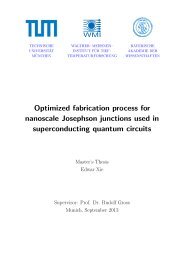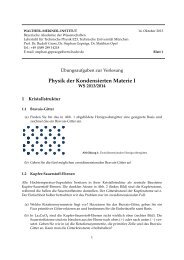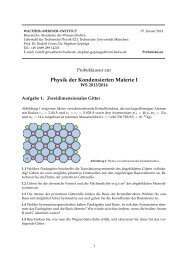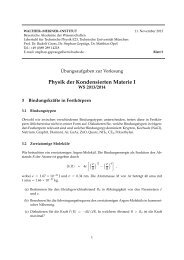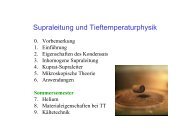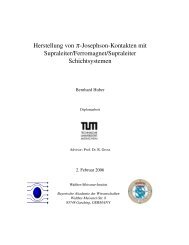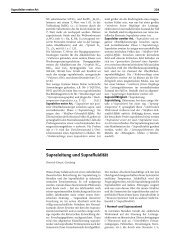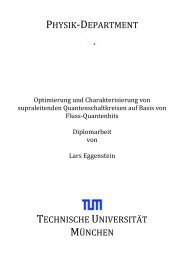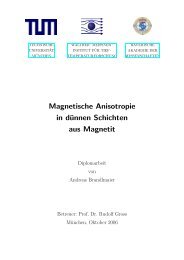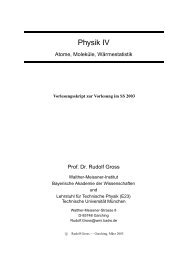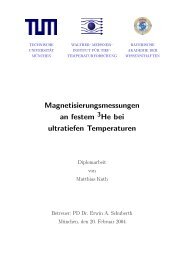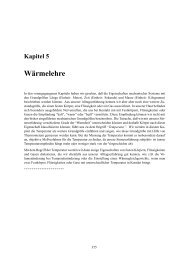Surface magneto-plasmons in magnetic multilayers - Walther ...
Surface magneto-plasmons in magnetic multilayers - Walther ...
Surface magneto-plasmons in magnetic multilayers - Walther ...
You also want an ePaper? Increase the reach of your titles
YUMPU automatically turns print PDFs into web optimized ePapers that Google loves.
Section 3.1<br />
Experimental setup 35<br />
Polariser/Analyser<br />
Calcite Glan Thompson polarisers are used as polariser and analyser. They consist<br />
of two calcite prisms which are glued at the base side. S<strong>in</strong>ce calcite is a birefr<strong>in</strong>gent<br />
material, <strong>in</strong> this configuration only one polarisation direction is transmitted. The<br />
used polarisers are from Thorlabs and have an ext<strong>in</strong>ction ratio of ε = 10 −6 .<br />
Sample preparation<br />
The metal films <strong>in</strong>vestigated are deposited onto 150 µm thick glass microscope slides<br />
made of D263M glass from Menzel with an refractive <strong>in</strong>dex of nD263M ≈ nBK7 = 1.514 1<br />
[62]. Prior to the th<strong>in</strong> film deposition, these were cleaned with isopropanol <strong>in</strong> an<br />
ultrasonic bath for a few m<strong>in</strong>utes. The metal films were deposited via electron beam<br />
evaporation (E-VAP, described <strong>in</strong> [63]) at room temperature with a base pressure of<br />
1 × 10 −8 mbar and with deposition rates of 1 − 2 Å/s. The deposited film thickness is<br />
controlled by an oscillat<strong>in</strong>g crystal which has an accuracy of ≈ 0.5% [64].<br />
Prism<br />
For the ATR coupler <strong>in</strong> this thesis, a BK7 (εBK7 = 1.514 2 [32]) right angle prism is<br />
used. Two different sizes are used, a prism with a side length of 20 mm and a prism<br />
with a side length of 5 mm. The ma<strong>in</strong> measurements were done with the 5 mm prism,<br />
s<strong>in</strong>ce it is much easier to handle than the 20 mm prism. It also allows a smaller gap<br />
size <strong>in</strong> the used electromagnet. A picture of the 5 mm prism is shown <strong>in</strong> Fig. 3.3.<br />
To be able to excite surface <strong>plasmons</strong>, the metal films have to be <strong>in</strong> contact with the<br />
prism. This is done by us<strong>in</strong>g an <strong>in</strong>dex match<strong>in</strong>g immersion oil from Richard-Allan<br />
Scientific with nd = 1.515 ≈ nd, BK7 = 1.516 2 . To remove the immersion oil from the<br />
prism, it is cleaned with isopropanol <strong>in</strong> an ultrasonic bath.<br />
Rotation stage<br />
As a rotation stage an old x-ray θ − 2θ table from Rich. Seifert & Co. is used. It is<br />
made out of two <strong>in</strong>dependently turnable stages, one <strong>in</strong>ner stage on which the prism<br />
is mounted and an outer stage on which the detector is mounted. Thus the θ − 2θ<br />
condition required can be achieved. To drive the rotation stages two stepper motors<br />
1n refers to λ = 650 nm. If no other wavelength is stated, then n and ε will always refer to<br />
λ = 650 nm.<br />
2The <strong>in</strong>dex d <strong>in</strong> n denotes λ = 587.6 nm



